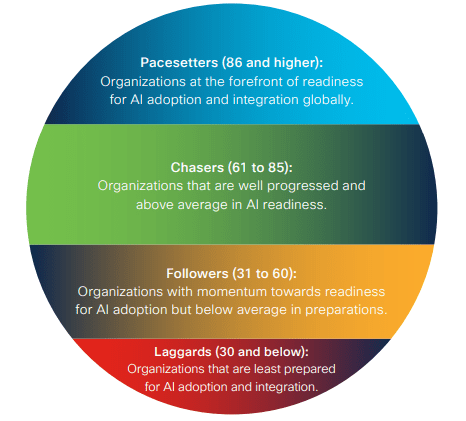Cisco released their Cisco AI Readiness Index, which among other things, highlighted how 2023 advancements in Generative AI, coupled with the public availability of these tools, are driving greater attention to the changes and new possibilities of AI.
Cisco Malaysia’s MD, Hana Raja described, “In our inaugural Cisco Global AI Readiness Index, we conducted a double-blind survey of over 8,100 private sector business and IT leaders across 30 markets to assess companies’ AI readiness but we did not rank them against each other. What the index did reveal was that countries’ intentions to deploy and leverage AI are outpacing their abilities to do so.
In Malaysia, she also underlined that there is a clear AI readiness gap in Malaysia, that is resounding in the rest of the world and that organizations must bridge.
The report revealed that in Malaysia, only 13% of organizations are fully prepared to deploy and leverage AI, while almost all (99%) reported that the urgency to deploy AI-powered technologies has increased in their company in the past six months.
Hana said there are critical gaps across key business pillars of strategy, infrastructure, data, governance, talent, and culture.
“This indicates that companies are still wrestling with how to address AI across their organizations—not just from a technology perspective, but also among the humans who are ready (or not) to use that technology.”

Emerging markets fare better
Cisco discovered that emerging markets are faring better in AI preparedness levels as compared to developed markets.
Hana explained, “This variance could be explained by the fact that companies in emerging markets started their digitization journeys more recently compared to their peers in developed markets.
“They may not have legacy systems holding them back, making it relatively easier to deploy and integrate AI and general tech solutions across their entire IT infrastructure.”

However, the main challenges organizations in Malaysia face in deploying and leveraging AI are on the six key business pillars mentioned in the report. While companies in Malaysia are making strides on pillars like Strategy, which emerged as the most mature pillar, they are facing challenges across other pillars:
Data: Despite data serving as the critical backbone and lifeblood necessary for AI operations, in Malaysia, Data has the largest number of organizations classified as Laggards (10%) and 47% falling into the Follower group.
With a broad set of data sitting across different domains, organizations need to prioritize a strong data strategy to unlock the true potential of AI. 8 in 10 (81%) admit that their data exists in silos across the organizations. Organizations’ analytics tools are not fully integrated with the data sources and AI platforms being used.
Governance: Governance readiness is also another area that companies need to look at with 67% of respondents reporting not having highly comprehensive AI policies and protocols in place. Almost 1 in 4 (22%) say they do not have systematic mechanisms to detect data biases.
Culture: Organizations need to make sure that talents are on board with AI acceleration. The culture pillar had the lowest number of Pacesetters (9%) compared to other categories driven largely by the fact that 21% of companies have not established change management plans yet and of those that have three-quarters (76%) are still in progress.
Best practices for capability building in 2024
The effective deployment of any initiative across an organization requires a well-defined strategy, and they should prioritize this to start with.
They may not have legacy systems holding them back, making it relatively easier to deploy and integrate AI and general tech solutions across their entire IT infrastructure.
The good news is that a majority of companies already have a highly defined AI strategy in place or are in the process of developing one, which is a positive sign, but there is more to be done. Organizations need to define their strategy and anchor that into their plans to deploy AI with clear ownership processes to measure impact and a healthy stream of funding.
Building infrastructure for the future: Companies need to make sure their IT infrastructure is highly scalable, flexible, and able to handle increasingly complex AI applications. This is where strong computing capabilities, network infrastructure, and automation are critical for an AI-ready infrastructure.
Breaking down data silos: To fully leverage AI, a centralized approach to data management is critical. They should first conduct an audit of existing data repositories to understand their structure and interconnections. Then, implement a centralized data management system that promotes data integration, uniformity, and accessibility across departments. Lastly, they should foster a collaborative culture, supported by clear policies and continuous training to ensure that people adhere to consistent data practices and share data as needed across departments.
Putting people at the core: Organizations should educate everyone to understand the power of AI and how to use it to their advantage and augment their workflows. But training is only half the job. A comprehensive change management plan is critical.
Deploying timely, internal policies and protocols: A rapidly evolving regulatory environment means that organizations need to keep abreast of the latest regulations and evaluate if their internal policies address data privacy, security, and the ethical use of AI. They should also implement robust cybersecurity measures with the potential vulnerabilities introduced by AI systems.
Hana concluded, “At Cisco, trust is very important to us. We developed a Responsible AI Framework based on six principles Transparency, Fairness, Accountability, Privacy, Security, and Reliability. We translate these principles into control that we apply to how we innovate. “








